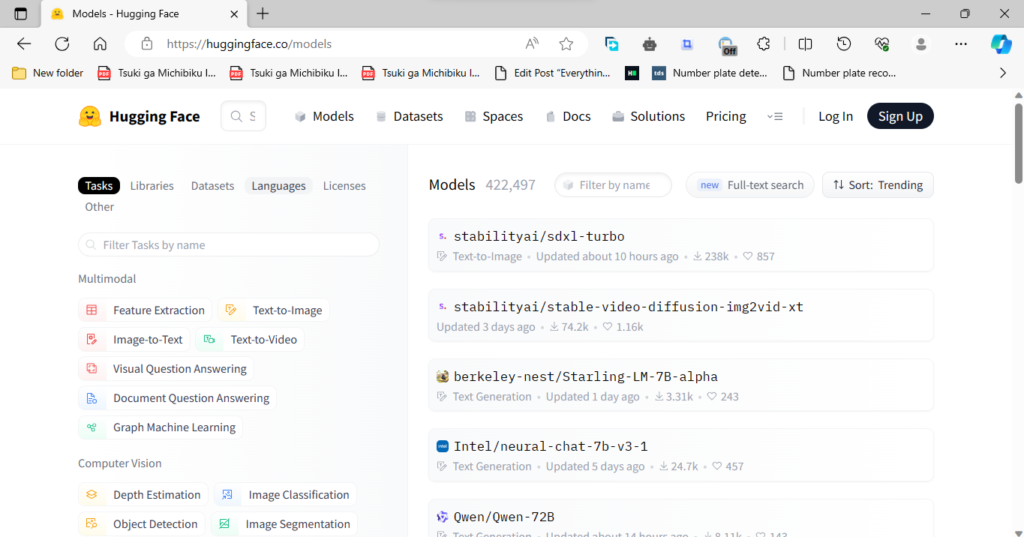Generate AI images as good as DALL-E completely offline.
Introducing Plethora of Stable Diffusion models: Part 1

In the past year or two, we’ve seen funny memes predicting how our favorite celebrities might look in the future, with wrinkles and white facial hair. This playful trend showcases the rise of technology like generative AI in creating customized images.


Now, what is generative AI?
Generative AI refers to artificial intelligence systems that can create new content, such as text, images, or other media, based on patterns and information learned from existing data. When a piece of code or AI system consistently delivers refined, current, and sought-after outcomes, it can be called as generative AI model. Some of the well known generative AI models are Generative Adversarial Networks (GANs), Variational Autoencoders (VAEs), Autoencoders, Boltzmann Machines, Stable Diffusion. In this article we are briefly talking about stable diffusion model.
Below, We are producing images from this UI which is taking prompt/command to generate customized image/picture with completely offline setup. This particular generative AI model is called a stable diffusion model. You can have a copyright-free image ready with your preferred style and dimensions within minutes.
Architecture of stable diffusion
The architecture of Stable Diffusion involves a latent diffusion model that generates images from text prompts. While the detailed architecture might vary, here is a general overview:
- Latent Diffusion Model: Stable Diffusion operates as a latent diffusion model, working in a lower-dimensional latent space rather than directly in the high-dimensional pixel space of images.
- Diffusion Process: The core of Stable Diffusion is a diffusion process. Unlike traditional generative models that apply diffusion directly to pixel images, Stable Diffusion performs diffusion in the latent space, enhancing efficiency.
- Text-to-Latent Conversion: To generate images from textual prompts, Stable Diffusion converts input text into a latent image representation. This involves encoding textual information into a format compatible with the latent space.
- Noise Prediction with U-Net: In many implementations, Stable Diffusion integrates a U-Net model for noise prediction. The U-Net takes encoded text and a noisy array of numbers as inputs, predicting noise patterns that enhance the latent image.
- Integration of Noise: The predicted noise from the U-Net is integrated into the diffusion process. This step refines the latent image representation by incorporating the predicted noise, contributing to the generation of detailed and coherent images.
- Image Generation: The final step involves generating high-quality images based on the refined latent image representation and the integrated noise. The generated images align with the provided textual descriptions or prompts.
It’s important to note that Stable Diffusion is a concept with variations in implementation. Different models may utilize unique architectures, and the integration of components like U-Net for noise prediction can vary. Understanding the specific architecture often requires referring to the details provided in the respective research papers, documentation, or articles related to a particular implementation of Stable Diffusion.
Stable Diffusion Models
These are some sites that host thousands of diffusion models easily downloadable for content(text, image, video) generation free of charge. Some sites also provide a way to use them online under a price range or model to model basis.
Installation and Use
In following steps, we will show you how to download and install stability-diffusion UI these pre-trained model are free to run as long as you have a powerful system to run them at full capacity.
Download & Install Stablity Diffusion UI
You need to consider installing the WSL if you don’t have a Linux system. Use this article to get your system prepared for stable diffusion click here. Use the following commands to install the web-UI.
(base) ubuntu@WorkBox:~/newoness$ git clone https://github.com/AUTOMATIC1111/stable-diffusion-webui
(base) ubuntu@WorkBox:~/newoness$ cd stable-diffusion-webui/
(base) ubuntu@WorkBox:~/newoness$ explorer.exe .
Following folder is where you will save the models you download. Make sure they have .safetensors file extension.

Download Model
civitai is one of the sites that provides you with pretrained models. Do explore the site there is a lot to generation models than just images. You can generate texts, voices, videos. And you can either use images or text prompts to generate.
Visit following links to find website that host stable diffusion models.
Stable Diffusion Model Sources
ANCOVA: Analysis of Covariance with python
ANCOVA is an extension of ANOVA (Analysis of Variance) that combines blocks of regression analysis and ANOVA. Which makes it Analysis of Covariance.
Learn Python The Fun Way
What if we learn topics in a desirable way!! What if we learn to write Python codes from gamers data !!
Meet the most efficient and intelligent AI assistant : NotebookLM
Start using NotebookLM today and embark on a smarter, more efficient learning journey!
Break the ice
This can be a super guide for you to start and excel in your data science career.
Model Context Protocol (MCP) — the “USB” for AI tools
MCP is the USB port for AI — A standard that lets models like ChatGPT safely connect to tools and servic
Manova Quiz
Solve this quiz for testing Manova Basics
Quiz on Group By
Test your knowledge on pandas groupby with this quiz
Visualization Quiz
Observe the dataset and try to solve the Visualization quiz on it
Versions of ANCOVA (Analysis Of Covariance) with python
To perform ANCOVA (Analysis of Covariance) with a dataset that includes multiple types of variables, you’ll need to ensure your dependent variable is continuous, and you can include categorical variables as factors. Below is an example using the statsmodels library in Python: Mock Dataset Let’s create a dataset with a mix of variable types: Performing…
Python Variables
How useful was this post? Click on a star to rate it! Submit Rating
A/B Testing Quiz
Complete the code by dragging and dropping the correct functions
Python Functions
Python functions are a vital concept in programming which enables you to group and define a collection of instructions. This makes your code more organized, modular, and easier to understand and maintain. Defining a Function: In Python, you can define a function via the def keyword, followed by the function name, any parameters wrapped in parentheses,…
Python Indexing: A Guide for Data Science Beginners
Mastering indexing will significantly boost your data manipulation and analysis skills, a crucial step in your data science journey.



